Civil Rights Icons’ Mothers, Lost Ancient Cities and Other New Books to Read
These February releases elevate overlooked stories and offer insights on oft-discussed topics
:focal(761x594:762x595)/https://tf-cmsv2-smithsonianmag-media.s3.amazonaws.com/filer/a4/56/a456d0c3-1c24-4da7-a0c6-acc8daf96f30/february_books.png)
Anna Malaika Tubbs has never liked the old adage of “behind every great man is a great woman.” As the author and advocate points out in an interview with Women’s Foundation California, in most cases, the “woman is right beside the man, if not leading him.” To “think about things differently,” Tubbs adds, she decided to “introduce the woman before the man”—an approach she took in her debut book, which spotlights the mothers of Martin Luther King Jr., Malcolm X and James Baldwin.
“I am tired of Black women being hidden,” writes Tubbs in The Three Mothers. “I am tired of us not being recognized, I am tired of being erased. In this book, I have tried my best to change this for three women in history whose spotlight is long overdue, because the erasure of them is an erasure of all of us.”
The latest installment in our series highlighting new book releases, which launched last year to support authors whose works have been overshadowed amid the Covid-19 pandemic, explores the lives of the women who raised civil rights leaders, the story behind a harrowing photograph of a Holocaust massacre, the secret histories of four abandoned ancient cities, humans’ evolving relationship with food, and black churches’ significance as centers of community.
Representing the fields of history, science, arts and culture, innovation, and travel, selections represent texts that piqued our curiosity with their new approaches to oft-discussed topics, elevation of overlooked stories and artful prose. We’ve linked to Amazon for your convenience, but be sure to check with your local bookstore to see if it supports social distancing–appropriate delivery or pickup measures, too.
The Three Mothers: How the Mothers of Martin Luther King, Jr., Malcolm X, and James Baldwin Shaped a Nation by Anna Malaika Tubbs
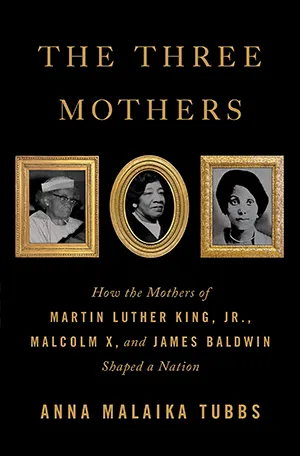
Ebenezer Baptist Church is perhaps best known for its ties to King, who preached there alongside his father, Martin Luther King Sr., between 1947 and 1968. The Atlanta house of worship proudly hails its ties to the Kings, but as Tubbs writes for Time magazine, one member of the family is largely left out of the narrative: King’s mother, Alberta.
The author adds, “Despite the fact that this church had been led by her parents, that she had re-established the church choir, that she played the church organ, that she was the adored Mama King who led the church alongside her husband, that she was assassinated in the very same building, she had been reduced to an asterisk in the church’s overall importance.”
In The Three Mothers, Tubbs details the manifest ways in which Alberta, Louise Little and Berdis Baldwin shaped their sons’ history-making activism. Born within six years of each other around the turn of the 20th century, the three women shared a fundamental belief in the “worth of Black people, … even when these beliefs flew in the face of America’s racist practices,” per the book’s description.
Alberta—an educator and musician who believed social justice “needed to be a crucial part of any faith organization,” as Tubbs tells Religion News Service—instilled those same beliefs in her son, supporting his efforts to effect change even as the threat of assassination loomed large. Grenada-born Louise, meanwhile, immigrated to Canada, where she joined Marcus Garvey’s black nationalist Universal Negro Improvement Association and met her future husband, a fellow activist; Louise’s approach to religion later inspired her son Malcolm to convert to the Nation of Islam. Berdis raised James as a single parent in the three years between his birth and her marriage to Baptist preacher David Baldwin. Later, when James showed a penchant for pen and paper, she encouraged him to express his frustrations with the world through writing.
All three men, notes Tubbs in the book, “carried their mothers with them in everything they did.”
The Ravine: A Family, a Photograph, a Holocaust Massacre Revealed by Wendy Lower
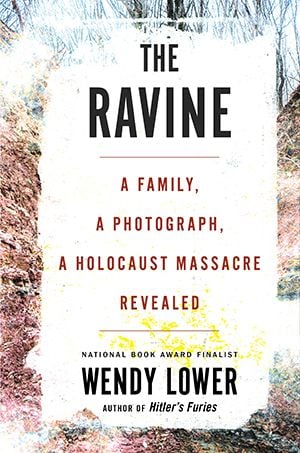
Few photographs of the Holocaust depict the actual moment of victims’ deaths. Instead, visual documentation tends to focus on the events surrounding acts of mass murder: lines of unsuspecting men and women awaiting deportation, piles of emaciated corpses on the grounds of Nazi concentration camps. In total, writes historian Wendy Lower in The Ravine, “not many more than a dozen” extant images actually capture the killers in the act.
Twelve years ago, Lower, also the author of Hitler's Furies: German Women in the Nazi Killing Fields, chanced upon one such rare photograph while conducting research at the United States Holocaust Memorial Museum. Taken in Miropol, Ukraine, on October 13, 1941, the photo shows Nazis and local collaborators in the middle of a massacre. Struck by a bullet to the head, a Jewish woman topples forward into a ravine, pulling two still-living children down with her. Robbed of a quick death by shooting, the youngsters were “left to be crushed by the weight of their kin and suffocated in blood and the soil heaped over the bodies,” according to The Ravine.
Lower spent the better part of the next decade researching the image’s story, drawing on archival records, oral histories and “every possible remnant of evidence” to piece together the circumstances surrounding its creation. Through her investigations of the photographer, a Slovakian resistance fighter who was haunted by the scene until his death in 2005; the police officers who participated in their neighbors’ extermination; and the victims themselves, she set out to hold the perpetrators accountable while restoring the deceased’s dignity and humanity—a feat she accomplished despite being unable to identify the family by name.
“[Genocide’s] perpetrators not only kill but also seek to erase the victims from written records, and even from memory,” Lower explains in the book’s opening chapter. “When we find one trace, we must pursue it, to prevent the intended extinction by countering it with research, education, and memorialization.”
Four Lost Cities: A Secret History of the Urban Age by Annalee Newitz
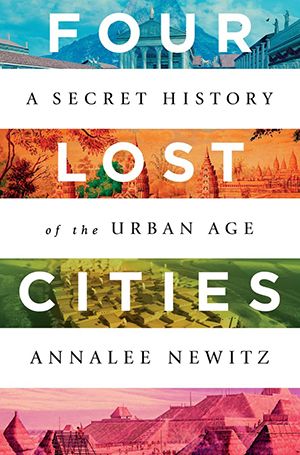
Sooner or later, all great cities fall. Çatalhöyük, a Neolithic settlement in southern Anatolia; Pompeii, the Roman city razed by Mount Vesuvius’ eruption in 79 A.D.; Angkor, the medieval Cambodian capital of the Khmer Empire; and Cahokia, a pre-Hispanic metropolis in what is now Illinois, were no exception. United by their pioneering approaches to urban planning, the four cities boasted sophisticated infrastructures and feats of engineering—accomplishments largely overlooked by Western scholars, who tend to paint their stories in broad, reductive strokes, as Publishers Weekly notes in its review of science journalist Annalee Newitz’s latest book.
Consider, for instance, Çatalhöyük, which was home to some of the first people to settle down permanently after millennia of nomadic living. The prehistoric city’s inhabitants “farmed, made bricks from mud, crafted weapons, and created incredible art” without the benefit of extensive trade networks, per Newitz. They also adorned their dwellings with abstract designs and used plaster to transform their ancestors’ skulls into ritualistic artworks passed down across generations. Angkor, on the other hand, became an economic powerhouse in large part thanks to its complex network of canals and reservoirs.
Despite their demonstrations of ingenuity, all four cities eventually succumbed to what Newitz describes as “prolonged periods of political instability”—often precipitated by poor leadership and unjust hierarchies—“coupled with environmental collapse.” The parallels between these conditions and “the global-warming present” are unmistakable, but as Kirkus points out, the author’s deeply researched survey is more hopeful than dystopian. Drawing on the past to offer advice for the future, Four Lost Cities calls on those in power to embrace “resilient infrastructure, … public plazas, domestic spaces for everyone, social mobility, and leaders who treat the city’s workers with dignity.”
Animal, Vegetable, Junk: A History of Food, From Sustainable to Suicidal by Mark Bittman
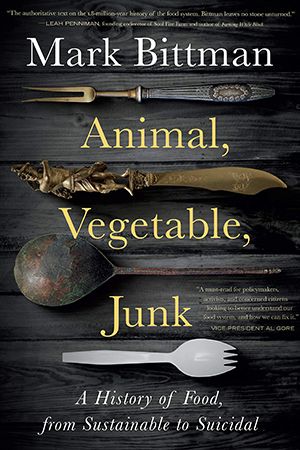
Humans’ hunger for food has a dark side, writes Mark Bittman in Animal, Vegetable, Junk. Over the millennia, the food journalist and cookbook author argues, “It’s sparked disputes over landownership, water use, and the extraction of resources. It’s driven exploitation and injustice, slavery and war. It’s even, paradoxically enough, created disease and famine.” (A prime example of these consequences is colonial powers’ exploitation of Indigenous peoples in the production of cash crops, notes Kirkus.) Today, Bittman says, processed foods wreak havoc on diets and overall health, while industrialized agriculture strips the land of its resources and drives climate change through the production of greenhouse gases.
Dire as it may seem, the situation is still salvageable. Though the author dedicates much of his book to an overview of how humans’ relationship with food has changed for the worse, Animal, Vegetable, Junk’s final chapter adopts a more optimistic outlook, calling on readers to embrace agroecology—“an autonomous, pluralist, multicultural movement, political in its demand for social justice.” Adherents of agroecology support replacing chemical fertilizers, pesticides and other toxic tools with organic techniques like composting and encouraging pollinators, in addition to cutting out the middleman between “growers and eaters” and ensuring that the food production system is “sustainable and equitable for all,” according to Bittman.
“Agroecology aims to right social wrongs,” he explains. “... [It] regenerates the ecology of the soil instead of depleting it, reduces carbon emissions, and sustains local food cultures, businesses, farms, jobs, seeds, and people instead of diminishing or destroying them.”
The Black Church: This Is Our Story, This Is Our Song by Henry Louis Gates Jr.
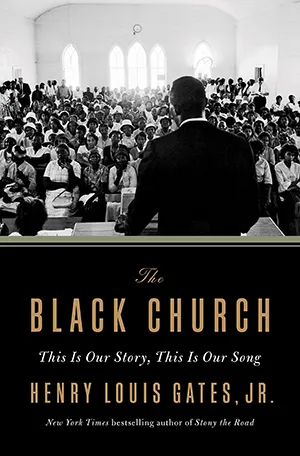
The companion book to an upcoming PBS documentary of the same name, Henry Louis Gates Jr.’s latest scholarly survey traces the black church’s role as both a source of solace and a nexus for social justice efforts. As Publishers Weekly notes in its review of The Black Church, enslaved individuals in the antebellum South drew strength from Christianity’s rituals and music, defying slaveholders’ hopes that practicing the religion would render them “docile and compliant.” More than a century later, as black Americans fought to ensure their civil rights, white supremacists targeted black churches with similar goals in mind, wielding violence to (unsuccessfully) intimidate activists into accepting the status quo.
Gates’ book details the accomplishments of religious leaders within the black community, from Martin Luther King Jr. to Malcolm X, Nat Turner and newly elected senator Reverend Raphael G. Warnock. (The Black Churches’ televised counterpart features insights from similarly prominent individuals, including Oprah Winfrey, Reverend Al Sharpton and John Legend.) But even as the historian celebrates these individuals, he acknowledges the black church’s “struggles and failings” in its “treatment of women and the LGBTQ+ community and its dismal response to the 1980s AIDS epidemic,” per Kirkus. Now, amid a pandemic that’s taken a disproportionate toll on black Americans and an ongoing reckoning with systemic racism in the U.S., black churches’ varying approaches to activism and political engagement are at the forefront once again.
As Gates says in a PBS statement. “No social institution in the Black community is more central and important than the Black church.”
/https://tf-cmsv2-smithsonianmag-media.s3.amazonaws.com/accounts/headshot/mellon.png)
/https://tf-cmsv2-smithsonianmag-media.s3.amazonaws.com/accounts/headshot/mellon.png)